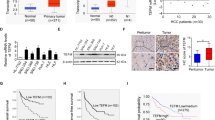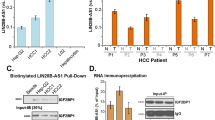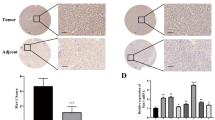Abstract
Hepatocellular carcinoma (HCC) is the sixth most common cancer worldwide. OKL38 is a pregnancy-induced growth inhibitory gene and its expression is lost in various breast cancer cell lines and kidney tumor. To determine the role of OKL38 expression in HCC, we investigated its expression in various HCC samples and liver cancer cell lines. Western blot analysis revealed that OKL38 protein was absent or reduced in 64.2% (18 of 28) of the HCCs examined and four liver cancer cell lines. Immunohistochemistry study demonstrated that OKL38 protein was undetectable in 41.3% (38 of 92) of HCC, whereas 39.1% (36 of 92) of HCC showed low expression of the protein. Lost or reduced expression level of OKL38 protein was significantly correlated to high tumor stages in HCC (P=0.0042). Overexpression of the OKL38 caused cell death in Chang liver cells. 5′ Untranslated region (5′UTR) deletion studies demonstrated that OKL38 was downregulated via translation suppression associated with the 5′UTR of its mRNA. Taken together, the 5′UTRs of OKL38 might play an important role in downregulation of its protein and the absence of OKL38 could lead to the development or progression of HCC.
This is a preview of subscription content, access via your institution
Access options
Subscribe to this journal
Receive 50 print issues and online access
$259.00 per year
only $5.18 per issue
Buy this article
- Purchase on Springer Link
- Instant access to full article PDF
Prices may be subject to local taxes which are calculated during checkout





Similar content being viewed by others
References
Akriviadis EA, Llovet JM, Efremidis SC, Shouval D, Canelo R, Ringe B et al. (1998). Hepatocellular carcinoma. Br J Surg 85: 1319–1331.
Altman DG, Machin D, Bryant TN, Gardner MJ . (2000). Statistics With Confidence. British Medical Journal Books: London.
Chan ES, Chow PK, Tai B, Machin D, Soo K . (2000). Neoadjuvant and adjuvant therapy for operable hepatocellular carcinoma. Cochrane Database Systemic Review (CD001199pp).
Claudio PP, Zamparelli A, Garcia FU, Claudio L, Ammirati G, Farina A et al. (2002). Expression of cell-cycle-regulated proteins PRb2/P130, P107, P27(Kip1), P53, Mdm-2, and Ki-67 (MIB-1) in prostatic gland adenocarcinoma. Clin Cancer Res 8: 1808–1815.
Clemens MJ . (2004). Targets and mechanisms for the regulation of translation in malignant transformation. Oncogene 23: 3180–3188.
Colombo M . (1992). Hepatocellular carcinoma. J Hepatol 15: 225–236.
Dua K, Williams TM, Beretta L . (2001). Translational control of the proteome: relevance to cancer. Proteomics 1: 1191–1199.
Gasteiger E, Hoogland C, Gattiker A, Duvaud S, Wilkins MR, Appel RD et al. (2005). The Proteomics Protocols Handbook Walker JM (ed). Humana Press: Totowa, NJ. pp 571–608.
Harigai M, Miyashita T, Hanada M, Reed JC . (1996). A cis-acting element in the BCL-2 gene controls expression through translational mechanisms. Oncogene 12: 1369–1374.
Huguet CSFaGA . (2000). Surgery of the Liver and Billary Tract Blumgart L (ed). Churchill Livingstone: London. pp 1365–1369.
Huynh H, Chow PK, Ooi LL, Soo KC . (2002). A possible role for insulin-like growth factor-binding protein-3 autocrine/paracrine loops in controlling hepatocellular carcinoma cell proliferation. Cell Growth Differ 13: 115–122.
Huynh H, Ng CY, Ong CK, Lim KB, Chan TW . (2001). Cloning and characterization of a novel pregnancy-induced growth inhibitor in mammary gland. Endocrinology 142: 3607–3615.
Kozak M . (1987). An analysis of 5′-noncoding sequences from 699 vertebrate messenger RNAs. Nucleic Acids Res 15: 8125–8148.
Kozak M . (1991). An analysis of vertebrate mRNA sequences: intimations of translational control. J Cell Biol 115: 887–903.
Kullmann M, Gopfert U, Siewe B, Hengst L . (2002). ELAV/Hu proteins inhibit P27 translation via an IRES element in the P27 5′UTR. Genes Dev 16: 3087–3099.
Lai EaWJ . (1994). Surgery of the Liver and the Biliary Tract Blumgart L (ed). Churchill Livingstone: London. pp 1349–1363.
Lai EC, Fan ST, Lo CM, Chu KM, Liu CL, Wong J . (1995). Hepatic resection for hepatocellular carcinoma. An audit of 343 patients. Ann Surg 221: 291–298.
Meijer HA, Thomas AA . (2002). Control of eukaryotic protein synthesis by upstream open reading frames in the 5′-untranslated region of an MRNA. Biochem J 367: 1–11.
Morris DR, Geballe AP . (2000). Upstream open reading frames as regulators of mRNA translation. Mol Cell Biol 20: 8635–8642.
Okuda K, Ohtsuki T, Obata H, Tomimatsu M, Okazaki N, Hasegawa H et al. (1985). Natural history of hepatocellular carcinoma and prognosis in relation to treatment. Study of 850 patients. Cancer 56: 918–928.
Ong CK, Ng CY, Leong C, Ng CP, Foo KT, Tan PH et al. (2004a). Genomic structure of human OKL38 gene and its differential expression in kidney carcinogenesis. J Biol Chem 279: 743–754.
Ong CK, Ng CY, Leong C, Ng CP, Ong CS, Nguyen TT et al. (2004b). Structural characterization of three novel rat OKL38 transcripts, their tissue distributions, and their regulation by human chorionic gonadotropin. Endocrinology 145: 4763–4774.
Parkin DM, Bray F, Ferlay J, Pisani P . (2005). Global cancer statistics, 2002. CA Cancer J Clin 55: 74–108.
Pickering BM, Willis AE . (2005). The implications of structured 5′ untranslated regions on translation and disease. Semin Cell Dev Biol 16: 39–47.
Riou P, Saffroy R, Comoy J, Gross-Goupil M, Thiery JP, Emile JF et al. (2002). Investigation in liver tissues and cell lines of the transcription of 13 genes mapping to the 16q24 region that are frequently deleted in hepatocellular carcinoma. Clin Cancer Res 8: 3178–3186.
Spiessl B, Beahrs OH, Hermanek P, Hutter RVP, Scheibe O, Sobin LH et al. (1992). In: Spiessl B (ed). Illustrated Guide to the TNM/PTNM Classification of Malignant Tumour, 3rd edn, 2nd rev. Springer Verlag: Berlin, Heidelberg, New York. pp 104–111.
Takenaka K, Kawahara N, Yamamoto K, Kajiyama K, Maeda T, Itasaka H et al. (1996). Results of 280 liver resections for hepatocellular carcinoma. Arch Surg 131: 71–76.
Wang T, Xia D, Li N, Wang C, Chen T, Wan T et al. (2005). Bone marrow stromal cell-derived growth inhibitor inhibits growth and migration of breast cancer cells via induction of cell cycle arrest and apoptosis. J Biol Chem 280: 4374–4382.
Willis AE . (1999). Translational control of growth factor and proto-oncogene expression. Int J Biochem Cell Biol 31: 73–86.
Acknowledgements
This work was supported by grants from A*STAR-BMRC (LS/00/019) to Huynh Hung.
Author information
Authors and Affiliations
Corresponding author
Additional information
Supplementary Information accompanies the paper on the Oncogene website (http://www.nature.com/onc).
Supplementary information
Rights and permissions
About this article
Cite this article
Ong, C., Leong, C., Tan, P. et al. The role of 5′ untranslated region in translational suppression of OKL38 mRNA in hepatocellular carcinoma. Oncogene 26, 1155–1165 (2007). https://doi.org/10.1038/sj.onc.1209896
Received:
Revised:
Accepted:
Published:
Issue Date:
DOI: https://doi.org/10.1038/sj.onc.1209896
Keywords
This article is cited by
-
OSGIN1 is a novel TUBB3 regulator that promotes tumor progression and gefitinib resistance in non-small cell lung cancer
Cellular and Molecular Life Sciences (2023)
-
The NRF2 transcriptional target, OSGIN1, contributes to monomethyl fumarate-mediated cytoprotection in human astrocytes
Scientific Reports (2017)



